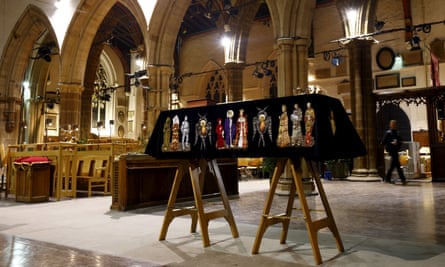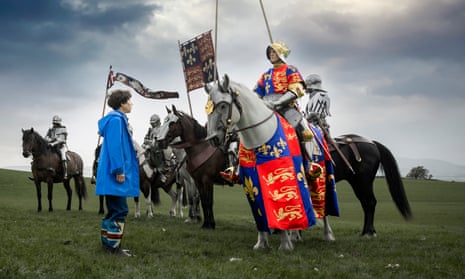I can actually remember where I was when it was announced that Richard III’s remains had been found under a car park in Leicester, 10 years ago. It made headlines globally, most likely because of the juxtaposition: “It’s a car park and it’s that king,” says Philippa Langley. “So it’s a really great story.”
Her agreement surprises me. Langley spent eight years looking for the remains of the king, after trying to restore his reputation for the previous decade. I don’t think it’s unfair to say that she thinks he is objectively the most interesting thing ever – and, from her perspective, this story doesn’t need any frilling up with the bathos of a private car park. But maybe she was just being polite.
Now 60, Langley dresses like a laidback person (double denim) and talks like a true believer, as passionate as she’s ever been about Richard III and scornful of the bad reputation unjustly heaped upon him by that rascal Shakespeare. We meet in London to discuss the film that Steve Coogan (reteaming with Philomena director Stephen Frears and co-writer Jeff Pope) has made about the discovery. Digressions from the film back to Richard’s true character are frequent. “When you look at the contemporary source material from his own lifetime,” she says, “it’s a very different man that you see: loyal, brave, pious.”
Langley is the founder of the Richard III Society’s Scottish branch, and was made its honorary president in 2015. The year after next, the organisation will celebrate its centenary. It’s stuffed with amateur Ricardians, but also medieval historians, specialists in ancient writing, experts across the board. They don’t all agree, but they keep it together in the service of their idol.

“There are some people,” Langley says with astonishment, “who actually love the Shakespeare play.” She corrects herself a bit. “Well, obviously, it’s Shakespeare. It’s one of the most dramatic works ever. But then, there’s an awful lot of people who feel there has been an injustice done.” Nevertheless, as a story, The Lost King is niche. It lacks the element of suspense since, whichever way you cut it, we already know that they find Richard III, and that he stays dead.
But The Lost King isn’t really about Richard III at all. I think it’s about Langley and the intensity of her fascination. She is brought vividly – and quite stressfully – to life by Sally Hawkins, while Coogan plays her ex-husband John. To stick my neck out further, I think the film’s deeper philosophical inquiry is about the wisdom we gain collectively from people who are obsessional and tenacious.
Let’s go back to the beginning. In 1992, Langley reads a biography of Richard III by Paul Murray Kendall and discovers the disconnect between the actual man and what we generally think of him – warlike, manipulative, murderous, not to mention “Deformed, unfinished, sent before my time / Into this breathing world, scarce half made up”. She thinks of writing a screenplay to rehabilitate him.
Langley was motivated by the injustice of it all, yet when I try to tease out the reason this injustice might have spoken to her, there doesn’t seem to be one. She was moderately interested in history as a kid, but didn’t do it as a degree. She worked in advertising and marketing. She didn’t think of herself as having been sinned against, particularly. She’s just from the north, she says with a shrug. “I was taught from a very early age that you don’t give in and you don’t give up.”
Langley was, at that time, having a phenomenally hard time. She’d been diagnosed with ME, was unable to work, had two small boys, her marriage had broken down, and she was making trips to Leicester for which she had to “sleep-bank” for two or three days beforehand. “I could never tell any of them [the academics and, later, archeologists], because it was one of those illnesses then: if people knew you had it, you were a bit odd. I couldn’t risk them thinking, ‘Who is this person?’”
Then, in 2004, an event which I had assumed was artistic licence when it appears on the screen actually happened. She was in Leicester, trying to piece together from her research the whereabouts of a long-gone church, and she walked across the fabled car park. “I felt that I was walking on his grave. I got this intuitive experience. I was covered in goosebumps and freezing cold, on this lovely warm, spring day.” Astonishingly, she shared this experience with friends and family and, even more astonishingly, they took her seriously, or at least, didn’t laugh. “So the next year, in the spring, I went back, to test if it was real. I had the exact same experience in the exact same place. But this time, I saw a hand-painted letter R on the tarmac. Well, it clearly stands for ‘reserved’. But that’s what changed my focus.”
From there - still skint, still with a chronic illness – Langley moves heaven and earth, or at least Leicester council, to get the car park dug up. It’s like something from a Fay Weldon novel (except her husband is lovely). She needs a lot of things: money for the dig, archeologists to believe her, more money for ground-penetrating radar pre-excavation – and above all, she needs to keep her nerve. “I was sidelined and marginalised. I was hugely vulnerable. Because I’m not a doctor. I’m not a professor. But in the end, I came to find my voice.”
It’s a bit of a Joan of Arc story, in the sense that you can’t help worrying that, had you been there, you’d have been on the side of the sniggering soldiers, not on the side of the solitary firebrand. I mean, seriously, would you dig a spot because it had given someone goosebumps (twice)?
The rest is history, but the history has been remade: you wouldn’t necessarily say Richard III’s reputation had been restored but the spike in interest, internationally, has breathed new life into research. By the way, say Langley, there was a great modernity to Richard, who enacted laws that “tried to raise the rights of ordinary people and give them access to justice”.
While she’s not at liberty to give me the details, new discoveries have already been made, by young historians going back to the source material. “You have to question traditional history,” Langley says, “because by questioning it, you make the most incredible discoveries.”
That’s the end of the car park’s starring role – and actually, in terms of the broader narrative, the end of Langley’s too. The University of Leicester basically sidelined her: Langley’s name wasn’t on the dig certificate and all the credit went to its archeological department. “I felt my role had been greatly diminished,” she says. “I’d done the research. I funded the dig and commissioned it. I didn’t really understand why they needed to do that to me. I used to be on friendly terms with the archaeologist. Well, I was up to the reburial.”
Langley’s project didn’t end with the discovery of the monarch’s remains, you see. “This was always a retrieval and reburial project,” she explains. “You don’t go looking for something unless you know what you’re going to do when you find it.” And this brought her many fresh battles and fresh enemies, right up to the archbishop of Canterbury. The powers that be wanted to put the remains in a “kind of a shoe box”, while she wanted a proper coffin. “I’d been to see the Commonwealth War Graves Commission, and they showed me, under strictest confidentiality, how they reburied the fallen. It was so respectful and so sensitive. I was in awe.”

She wanted Richard III laid out anatomically, with a monument that was pertinent to the true him, with a proper royal coat of arms, since he was a true monarch and definitely not a murdering usurper. She wanted him buried in a Catholic place of sanctity, too, but that’s where the archbishop drew a line. “Very disappointing,” she says, “but it’s one of those things.”
Here’s the thing: her disappointment doesn’t sound very authentic. She sounds like a person just pretending to have given up. I wouldn’t be surprised to wake up in 2032 and hear over the radio that loyal, brave, pious Richard III has had his grave resituated, from Leicester Cathedral to some more Catholic place, thanks to this one, remarkable superfan.
This article was amended on 1 September 2022. An earlier version featured an image of a coffin being raised at the Leicester car park site. This coffin did not contain the remains of Richard III and the image has been removed to avoid any potential for confusion.
